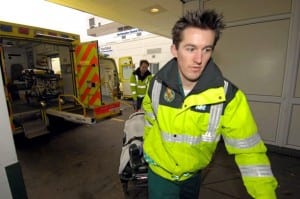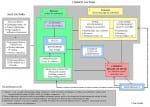 The results of a national Quality Improvement Collaborative study, the Ambulance Services Cardiovascular Quality Initiative (ASCQI) were published this week in the international academic journal Implementation Science. The article entitled The effect of a national quality improvement collaborative on prehospital care for acute myocardial infaction and stroke in England showed large and significant improvements in the quality of care provided by 11 ambulance services (out of 12) in England for people with heart attack and stroke. Members of the CaHRU team involved in the study included Professor Siriwardena, Dr Zowie Davy and Fiona Togher together with visiting fellows at CaHRU who are members of the research team at EMAS including Anne Spaight, Debbie Shaw and Nadya Essam. Professor Michael Dewey, chair in epidemiological statistics in London was the statistician on the project.
The results of a national Quality Improvement Collaborative study, the Ambulance Services Cardiovascular Quality Initiative (ASCQI) were published this week in the international academic journal Implementation Science. The article entitled The effect of a national quality improvement collaborative on prehospital care for acute myocardial infaction and stroke in England showed large and significant improvements in the quality of care provided by 11 ambulance services (out of 12) in England for people with heart attack and stroke. Members of the CaHRU team involved in the study included Professor Siriwardena, Dr Zowie Davy and Fiona Togher together with visiting fellows at CaHRU who are members of the research team at EMAS including Anne Spaight, Debbie Shaw and Nadya Essam. Professor Michael Dewey, chair in epidemiological statistics in London was the statistician on the project.
 The project has been part of a programme of work, Prehospital and Emergency Quality and Outcomes, developed through collaboration between academics from the Community and Health Research Unit and ambulance services across the United Kingdom, particularly East Midlands Ambulance Service NHS Trust (EMAS). This collaboration has enabled a strategic partnership between the University of Lincoln and EMAS to undertake research which is relevant to ambulance services, focusing on health issues of regional and national importance, and conducted with ambulance staff in order to increase the impact of the research by improving prehospital care for emergencies.
The project has been part of a programme of work, Prehospital and Emergency Quality and Outcomes, developed through collaboration between academics from the Community and Health Research Unit and ambulance services across the United Kingdom, particularly East Midlands Ambulance Service NHS Trust (EMAS). This collaboration has enabled a strategic partnership between the University of Lincoln and EMAS to undertake research which is relevant to ambulance services, focusing on health issues of regional and national importance, and conducted with ambulance staff in order to increase the impact of the research by improving prehospital care for emergencies.
 The study examined the period between January 2010 and February 2012. Across England overall, the percentage of emergency cases where care bundles (packages of essential care) were delivered in full increased from 43% to 79% for heart attack and from 83% to 96% for stroke. ASCQI supported frontline staff, and their management, to introduce improvements using checklists, aide memoires, individual and group feedback and sharing of information within and between different trusts to improve the reliability of care for people with heart attack and stroke. The project was shortlisted for an HSJ award in 2012.
The study examined the period between January 2010 and February 2012. Across England overall, the percentage of emergency cases where care bundles (packages of essential care) were delivered in full increased from 43% to 79% for heart attack and from 83% to 96% for stroke. ASCQI supported frontline staff, and their management, to introduce improvements using checklists, aide memoires, individual and group feedback and sharing of information within and between different trusts to improve the reliability of care for people with heart attack and stroke. The project was shortlisted for an HSJ award in 2012.














